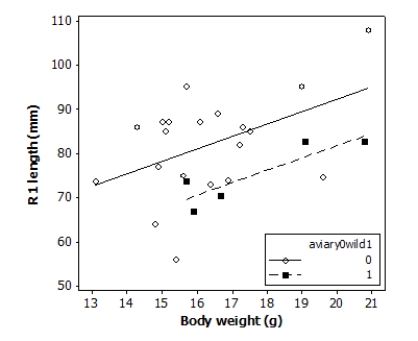Multiple Choice
Tail-feather length is a sexually dimorphic trait in long-tailed finches; that is, the trait differs substantially for males and for females of the same species. A bird's size and environment might also influence tail-feather length. Researchers studied the relationship between tail-feather length (measuring the R1 central tail feather) and weight in a sample of 20 male long-tailed finches raised in an aviary and 5 male long-tailed finches caught in the wild. The data are displayed in the scatterplot below.
 The following model is proposed for predicting the length of the R1 feather from the bird's weight and origin:
The following model is proposed for predicting the length of the R1 feather from the bird's weight and origin:
R1Lengthi = β0 + β1 (BodyWeighti) + β2 (Aviary0Wild1i) + εi
Where the deviations εi were assumed to be independent and Normally distributed with mean 0 and standard deviation σ . This model was fit to the sample of 25 male finches. The following results summarize the least-squares regression fit of this model:
Suppose we wish use the ANOVA F test to test the following hypotheses:
H0: β1 = β2 = 0
Hα: At least one of β1 or β2 is not 0
What is the P-value of this test?
A) Greater than 0.10
B) Between 0.05 and 0.10
C) Between 0.01 and 0.05
D) Less than 0.01
Correct Answer:

Verified
Correct Answer:
Verified
Q2: Researchers investigated the effects of acute
Q3: Researchers investigated the effects of acute
Q4: Researchers investigated the effects of acute
Q5: A case study enrolled case individuals
Q6: Researchers investigated the effects of acute
Q8: A study looked for a protein
Q9: Researchers investigated the effects of acute
Q10: Researchers investigated the effects of acute
Q11: A case study enrolled case individuals
Q12: Researchers investigated the effects of acute